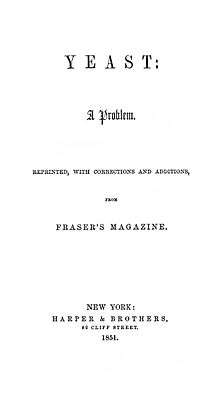Yeast (novel)
Yeast: A Problem (1848) was the first novel by the Victorian social and religious controversialist Charles Kingsley.

Themes and sources
Motivated by his strong convictions as a Christian Socialist Kingsley wrote Yeast as an attack on Roman Catholicism and the Oxford Movement, on celibacy, the game laws, bad landlords and bad sanitation, and on the whole social system insofar as it kept England’s agricultural labourer class in poverty.[1][2][3] The title was intended to suggest the "ferment of new ideas".[4]Yeast was influenced by the works of the philosopher Thomas Carlyle, and by Henry Brooke's novel The Fool of Quality.[5][6]
Publication
Yeast was first published in instalments in Fraser's Magazine, starting in July 1848, but as the radicalism of Kingsley's ideas became apparent the magazine's publisher took fright and induced the author to bring his novel to a premature close.[3] In 1851 it appeared in volume form.[7]
Criticism
It is sometimes said that Yeast suffers from its over-reliance on long conversations between its hero, Lancelot Smith, and the subsidiary characters of the novel, and from Kingsley's failure to integrate these discussions into anything resembling a coherent plot.[7][8] On the other hand many have admired the vividness of Kingsley's depiction of the degradation and grinding poverty of the lower classes in the English shires.[9][1]
Footnotes
- Ousby 1996, p. 434.
- Romano, Terrie M. (2002). "Medical Officer of Health". Making Medicine Scientific: John Burdon Sanderson and the Culture of Victorian Science. Baltimore: Johns Hopkins University Press. ISBN 0801868971. Retrieved 25 August 2013.
- Vance & 2004-2013.
- Ross, Angus (1971). "Kingsley, Charles". In Daiches, David (ed.). The Penguin Companion to Literature. Volume 1: Britain and the Commonwealth. Harmondsworth: Penguin. p. 293. Retrieved 25 August 2013.
- Birch, Dinah (2009). "Fool of Quality, The". The Oxford Companion to English Literature. Oxford University Press. Retrieved 25 August 2013.
- Walker, Hugh (2011) [1913]. Outlines of Victorian Literature. Cambridge: Cambridge University Press. p. 139. ISBN 9781107600096. Retrieved 25 August 2013.
- Birch 2009.
- Ward & 1964-1967, p. 360.
- Ward & 1964-1967, p. 361.
References
- Birch, Dinah (2009). "Yeast: A Problem". The Oxford Companion to English Literature. Oxford University Press.
- Ousby, Ian (1996). Cambridge Paperback Guide to Literature in English. Cambridge: Cambridge University Press. p. 434. ISBN 0521436273.
ideas in which Lancelot.
- Vance, Norman (2004–2013). "Kingsley, Charles". Oxford Dictionary of National Biography. Oxford University Press.
- Ward, A. W.; Waller, A. R., eds. (1964–1967). The Cambridge History of English Literature. Volume 13. Cambridge: Cambridge University Press.
External links
- Full text at the Internet Archive